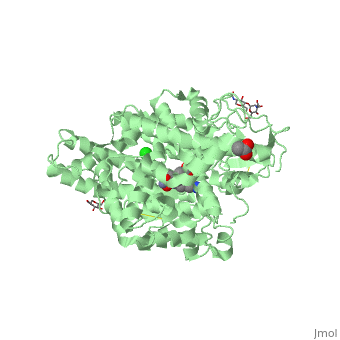Function
Lisinopril is an orally active angiotensin-converting enzyme inhibitor, or ACE inhibitor, used primarily to lower blood pressure. Lisinopril works by antagonizing the effect of the renin-angiotensin-aldosterone system (RAAS), which is a homestatic mechanism for regulating hemodynamics, water and electrolyte balance. During sympathetic stimulation or when renal blood pressure or blood flow is reduced, renin is released from the granular cells of the juxtaglomerular apparatus in the kidneys. In the blood stream, renin cleaves circulating angiotensinogen to angiotensin I (ATI), which is subsequently cleaved to angiotensin II (ATII) by the enzyme ACE. ATII increases blood pressure using a number of mechanisms. ACE inhibitors inhibit the rapid conversion of ATI to ATII, and also antagonize RAAS-induced increases in blood pressure. ACE (also known as kininase II) is also involved in the enzymatic deactivation of bradykinin, which is a vasodilator. When the deactivation of bradykinin is inhibited, bradykinin levels are increased and this can further sustain the effects of lisinopril by causing increased vasodilation and decreased blood pressure.[1] Overall, lisinopril inhibits the substances in the body that cause blood vessels to tighten, and as a result lisinopril relaxes the blood vessels and therefore lowers blood pressure and increases the supply of blood and oxygen to the heart.[2]
Structure
is a synthetic angiotensin-converting enzyme inhibitor (ACE inhibitors) with molecular formula of C21+H31+N3+O5, empirical formula of C21+H31+N3+O5*2H2O, and average molecular weight of 405.495 g/mol. It is primarily used for the treatment of hypertension[3]. Lisinopril is typically in the trans isometric form because it has a lower steric repulsion between the hydroxyl and carboxyl groups than the cis conformation and is biologically active in this form [4].
Structural highlights
Lisinopril has a benzene ring and from there it has a 4-carbon amide chain where it branches of into a carboxylic acid group one way and a secondary amide group the other way which connects to the rest of the molecule. From the secondary amide, the molecule branches into a 5-carbon amine with a primary amide at the end. The other branch from the secondary amide has a ketone bonded to a nitrogen in a 4-carbon ring. From this carbon ring, there is a carboxylic acid group.
Mechanism
Lisinopril is a drug used mainly to treat hypertension but also to reduce the risk of long-term damage and death in patients suffering from heart failure. Lisinopril controls blood pressure by inhibiting the angiotensin converting enzyme (ACE) and ceasing the degradation of Bradykinin (Bk), a vasodilator, signaled by the presence of ATII. By inhibiting ACE, it inevitably prevents the body from synthesizing angiotensin II. Without the surplus of angiotensin II being made, the blood pressure in the body lowers due to the increase in the ratio of vasodilating angiotensin I to vasoconstricting angiotensin II and preventing the inhibition of Bk.[5]
There are two types of membrane associated ACE proteins within the body. Coded by the same gene, the somatic and testis ACEs are closely similar though display some differences. The testes ACE protein consists of two domains which include their own individual HEXXH which forms many ligands that catalyze the hydrolysis of many mechanisms. In respect to Lisinopril, the zinc ions are involved with the hydrolysis of angiotensin I where the His-Leu dipeptide residues are cleaved at the C domain which restricts access to the active site. The binding position in the C domains controls the conversion of angiotensin. Therefore, when Lisinopril binds, ACE becomes distorted and curved. This curved and helical structure is known as tACE. This helical structure is formed via the chloride ions near the active site which begin substrate hydrolysis in the C domain. Lisinopril is known to bind to the individual HEXXH zinc binding motif in the lysine side chain in addition the extended phenyl group near the active site. [6].
The somatic angiotensin converting enzyme, or sACE, contains two highly functional active sites at the C terminus and N terminus. The C terminus of sACE and tACE are highly analogous, though each sACE terminus bears the zinc binding domain HEMGH, different from tACE’s HEXXH. Each sACE domain acts to convert ATI to ATII and to inactivate Bk. However, relative to the N terminus, the of the somatic enzyme is known to be less chemically stable and more reactive to environmental Cl- ions than its counter. Lisinopril acts with specificity to block the N and C terminus active sites.It competitively binds to sACE via hydrogen bonds, stacking of aromatic rings, and ionic interactions. Both the hydrophilic portions and hydrophobic aromatic rings of tyrosine and phenylalanine residues at the C-terminus of sACe interact with Lisinopril at the S2 binding site, coupling to create more favorable reactions. The aromatic rings present throughout the amino acid strand create a favorable nonpolar environment while those facets such as the hydrophilic ends allow for the molecule to interact with different types of substrate. The N-terminus of sACE, however, forms weaker and less favorable interactions between the sACE and ACE inhibitor relative to the C-terminus. A salt bridge formation between Glu residues of sACE allow Lisinopril access to its , compensating for the relatively weak interactions of the N-terminus end [7]

